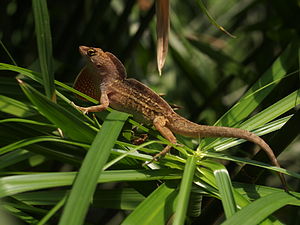Bahama anole
| Bahama anole | ||||||||||||
|---|---|---|---|---|---|---|---|---|---|---|---|---|

Bahamaanolis ( Norops sagrei ) |
||||||||||||
| Systematics | ||||||||||||
|
||||||||||||
| Scientific name | ||||||||||||
| Norops sagrei | ||||||||||||
| ( Duméril & Bibron , 1837) |
The Bahamaanolis ( Norops sagrei , Syn . : Anolis sagrei ) is a species from the group of iguanas .
description
In contrast to its relative, the lively green-colored red throat anole , the Bahama anole has a brown base tone, which is nuanced in many light and dark, up to black tones. Their back pattern is much more pronounced than in the red throat anole and can have yellow-whitish spots in places.
With a body length of up to 18 centimeters (males) or 17 centimeters (females), the Bahama anole is one of the small anole species . The Bahama anole is slightly larger in comparison to the red throat anole and the males in particular have a much more massive physique than their relatives. Their head is shorter and wider than that of the red throat anole.
The males have a pronounced throat pouch that can be set up for courtship, as an act of showing off, threatening gestures or for sunbathing. The female has a minimally formed throat pouch.
distribution
The Bahamaanolis colonizes some Caribbean islands, including Cuba and the eponymous Bahamas . The subspecies Norops sagrei sagrei living in Cuba is differentiated from the subspecies Norops sagrei ordinatus in the Bahamas.
This type of anole was also found on other islands such as Jamaica and Grand Cayman, as well as on the North and Central American mainland, e.g. B. introduced in Belize , Honduras and Mexico . The spread in the USA , starting from Florida, has been particularly well studied . Bahama anoles can even be found in Hawaii and on the East Asian Pacific island of Taiwan .
The species is very adaptable and therefore gets along well with the cooler climate in Florida. This meant that it could also spread north to the states of Georgia , Louisiana and Texas . It is believed that the anole is also spread by truck transport, as populations in the north are often first found near motorway service stations. The Bahama anole occurs mainly in the very south of Florida and on the so-called Florida Keys in mangrove forests on the coast. In Florida it displaces the native red throat anole.
Way of life
Even if Norops sagrei can climb well, he usually only stays at low heights, the males sit up to a meter above the ground, where they lurk upside down for prey . They occupy territories which in nature cover an average of around 37 square meters and are located in the vicinity of the trees or hedges on which they mainly stay.
nutrition
The animals meet their water needs mainly from dew drops that they lick from leaves, and they rarely drink from stagnant water. The main component of the diet are insects, they catch crickets, crickets, spiders, butterflies and, above all, flies, but they also feed on insect larvae, worms and snails. They also eat smaller lizards and young anoles of other species, as well as parts of the skin and lizard eggs that are shed during molting. Sometimes they also eat fresh fruit.
Life cycle
The young hatch from the egg after around 29 days, but this also depends on environmental conditions such as temperature and humidity . After hatching in early June, the young are 15 to 18 millimeters in size. The young grow very quickly and reach sexual maturity in the following year. In northern latitudes, for example in Florida, most of a population dies in the following winter, which means that they live for less than 18 months. However, under favorable conditions, the Bahama Anole can live for several years.
attitude
Since the water absorbed mainly comes from the dew on the leaves , the plants should be sprayed regularly if there is no mist in the terrarium. However, a drinking bowl should also be provided. The humidity in the air is also of great importance for molting, as skin that is too dry cannot be completely peeled off, which impairs the ability to see above the eyes and thus leads to starvation.
Anoles also need lime, so the feed animals should be dusted with lime before feeding to ensure an adequate supply of nutrients. Young animals only eat very small insects (micro-crickets etc.). Food animals should be fed at least twice a week.
Taxonomy
The specific epithet sagrei was chosen in honor of the scientist and politician Ramón de la Sagra, who worked in Cuba in the 1820s and later emigrated to France, and should therefore be called sagrai . The spelling mistake from the first description is retained according to the rules of the ICZN .
literature
- Iris Zeilfelder, Uwe Bartelt: The Bahamian anolis. Anolis sagrei. Natur-und-Tier-Verlag, Münster 2006, ISBN 3-93728-562-8 .
- Axel Fläschendräger, Leo CM Wijffels: Anolis. In the biotope and terrarium. 2nd, completely revised and enlarged edition. Natur-und-Tier-Verlag, Münster 2009, ISBN 3-86659-091-1 .
Individual evidence
- ↑ Julian C. Lee: Anolis sagrei in Florida: Phenetics of a colonizing species I. Meristic characters. In: Copeia. Vol. 1985, No. 1, 1985, pp. 182-194, doi : 10.2307 / 1444808 .
